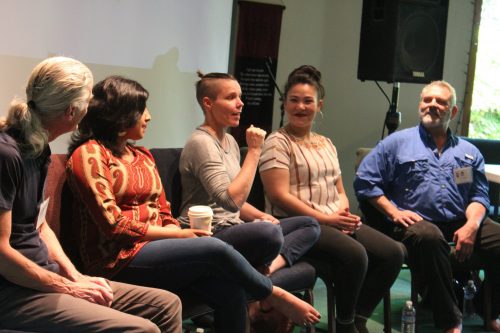 The ideas of C.G. Jung (1875-1961) remain a valuable source of guidance into the world of dreaming. Many other theories have been proposed since his time, and some of his thinking now appears outdated in light of later scientific and cultural developments. But his core works on the nature and meanings of dreaming still stand as perhaps the most deeply insightful writings about dreams of any Western psychologist, past or present.
The ideas of C.G. Jung (1875-1961) remain a valuable source of guidance into the world of dreaming. Many other theories have been proposed since his time, and some of his thinking now appears outdated in light of later scientific and cultural developments. But his core works on the nature and meanings of dreaming still stand as perhaps the most deeply insightful writings about dreams of any Western psychologist, past or present.
Below is a brief outline of some of the major concepts and themes in Jung’s theory of dreams.
Lots of agreement with Freud, and one big difference
Jung learned several key ideas from his early mentor Sigmund Freud (1856-1939). Both Jung and Freud agreed that dreaming is a meaningful product of unconscious forces in the psyche with roots deep in the evolutionary biology of our species. Both of them agreed that dreams are valuable allies in healing people suffering from various kinds of mental illness. They both used the best neuroscience of their day to inform their theories, and they both went beyond the limits of brain science to seek insights about the nature of dreaming in mythology, history, and art. Both of them believed a greater knowledge of dreaming can help us better understand the philosophical mysteries of how the mind and body interact.
The most fundamental difference in Freud’s and Jung’s dream theories was this: Freud’s approach looked backwards, and focused on the causal sources of dreams in early life experiences. Jung’s approach looked forwards, and tried to understand where the dreams might be leading, and what they might reveal about the individual’s future life development.
Compensation
The primary function of dreaming, according to Jung, is psychological compensation. Dreams help maintain a healthy, dynamic balance between consciousness and the unconscious. When the waking ego becomes too one-sided, or if it tries to repress a part of the unconscious, dreams will emerge to highlight the imbalance and guide the individual back on a path towards becoming a more integrated self.
“The fundamental mistake regarding the nature of the unconscious is probably this: it is commonly supposed that its contents have only one meaning and are marked with an unalterable plus or minus sign. In my humble opinion, this view is too naïve. The psyche is a self-regulating system that maintains its equilibrium just as the body does. Every process that goes too far immediately and inevitably calls forth compensations, and without these there would be neither a normal metabolism nor a normal psyche. In this sense we can take the theory of compensation as a basic law of psychic behavior…. When we set out to interpret a dream, it is always helpful to ask: What conscious attitude does it compensate?” (1934, 101)
Reductive compensations
Sometimes the compensation can take a critical form, which Jung called reductive compensations. Dreams sometimes bring a chastening dose of humility when the waking ego becomes too inflated or self-important (the ancient Greeks called it hubris). According to Jung, dreams give us honest portrayals of who we really are. If we think too highly of ourselves, the compensatory nature of the psyche will bring forth dreams that bring us back down into our depths. If we are too impressed with our own goodness and moral righteousness, we will be prone to dreams reminding us of our sins, our failings, our evil impulses, our hypocritical rationalizations and ego-protecting deceptions.
“There are people whose conscious attitude and adaptive performance exceed their capacities as individuals; that is to say, they appear to be better and more valuable than they really are…. They have not grown inwardly to the level of their outward eminence, for which reason the unconscious in all these cases has a negatively compensating, or reductive, function…. Every appearance of false grandeur and importance melts away before the reductive imagery of the dream, which analyses his conscious attitude with pitiless criticism and brings up devastating material containing a complete inventory of all his most painful weaknesses.” (1948a, 43-45)
The prospective function
Dreams can have many different functions, and Jung did not insist that every dream fits into one of his categories. But in addition to compensation, he proposed another major function of dreaming which he called the prospective function. This is not prophecy, although it does overlap with traditional religious views about dreams offering glimpses and visions of possibilities for the future. Jung said the prospective function focuses primarily on the future growth of the individual, along the path towards greater psychological integration and wholeness. If we can learn to understand these prospective dreams, they can offer an important source of unconscious intelligence and insight.
“The prospective function is an anticipation in the unconscious of future conscious achievements, something like a preliminary exercises or sketch, or a plan roughed out in advance…. That the prospective function of dreams is sometimes greatly superior to the combinations we can consciously foresee is not surprising, since a dream results from the fusion of subliminal elements and is thus a combination of all the perceptions, thoughts, and feelings which consciousness has not registered because of their feeble accentuation…. With regard to prognosis, therefore, dreams are often in a much more favorable position than consciousness.” (1948a, 41-42)
Archetypal images and “big dreams”
Jung put great emphasis on dreams with extremely vivid images. He regarded them as expressions of deeper unconscious patterns of instinctual meaning and wisdom he called “archetypes.” These dream images help to connect us with the primal energies of the psyche, whose ultimate developmental goal is our wholeness as humans, what Jung calls “individuation.” Hence Jung’s interest in the distinction between “big” and “little” dreams. Big dreams revolve around powerful archetypal images from the collective unconscious. Such dreams are guideposts along the path of individuation.
“Not all dreams are of equal importance. Even primitives distinguish between ‘little’ and ‘big’ dreams, or, as we might say, ‘insignificant’ and ‘significant’ dreams. Looked at more closely, ‘little dreams are the nightly fragments of fantasy coming from the subjective and personal sphere, and their meaning is limited to the affairs of the everyday. That is why such dreams are easily forgotten, just because their validity is restricted to the day-to-day fluctuations of the psychic balance. Significant dreams, on the other hand, are often remembered for a lifetime, and not infrequently prove to be the richest jewel in the treasure-house of psychic experience.” (1948b, 76)
Dreaming is like a theater
One of the metaphors Jung used to explain his theory of dreaming is to compare it to an inner theater. It became the basis for his notion of “subjective” dream interpretation, and for his ideas about dreaming and the origins of religion.
“The whole dream-work is essentially subjective, and a dream is a theater in which the dreamer is himself the scene, the player, the prompter, the producer, the author, and the critic. This simple truth forms the basis for a conception of the dream’s meaning which I have called interpretation on the subjective level. Such an interpretation, as the term implies, conceives all the figures in the dream as personified features of the dreamer’s own personality.” (1948a, 52)
In several places he described a four-part model of interpretation that used concepts from the classical world of theater and dramatic performance. According to this model, dreams tend to start with an exposition of the characters and setting. Next comes the development, as the characters interact within these settings and the forms and qualities of a story takes shape. After that comes what Jung called the peripateia or culmination of the story, a moment of tension or conflict. Sometimes the dream ends here, like a cliff-hanger, without any conclusion. But sometimes there is a resolution or lysis that overcomes the conflict by transforming into something new and unexpected.
“Most dreams show this dramatic structure. The dramatic tendency of the unconscious also shows in the primitives: here, possibly everything undergoes a dramatic illustration. Here lies the basis from which the mystery dramas developed. The whole complicated ritual of later religions goes back to these origins.” (2008, 31)
Humility in the process of interpretation
An appealing aspect of Jung’s approach to dreams is his openness to multiple possible interpretations. He had his hunches and his favorite ideas, of course, but he tried to be clear that dreams never have just one meaning, and he was never entirely sure if his own interpretations were reaching the most important levels of significance.
“So difficult is it to understand a dream that for a long time I have made it a rule, when someone tells me a dream and asks for my opinion, to say first of all to myself: ‘I have no idea what this dream means.’ After that I can begin to examine the dream.” (1948b, 69)
The value of exploring dreams in series
This difficulty in making sense of the strange archetypal images from the unconscious is why Jung advised more attention to series of dreams than to individual dreams. By looking at a large collection of dreams gathered over time, the patterns in these images become easier to identify. Dreams experienced on different nights may all revolve around the same archetype, expressing its meanings in a variety of symbolic forms.
“Every interpretation is a hypothesis, an attempt to read an unknown text. An obscure dream, taken in isolation, can hardly ever be interpreted with any certainty. For this reason, I attach little importance to the interpretation of single dreams. A relative degree of certainty is reached only in the interpretation of a series of dreams, where the later dreams correct the mistakes we have made in handling those that went before. Also, the basic ideas and themes can be recognized much better in a dream-series, and I therefore urge my patients to keep a careful record of their dreams and of the interpretations given.” (1934, 98)
Downsides
These are among Jung’s most valuable insights on the nature, functions, and meanings of dreams. As he described in his memoir Memories, Dreams, Reflections, he drew many of his key concepts and ideas from his own personal experiences. Thus it is difficult to separate his theories from his life—and his life had many troubling aspects. He had numerous extramarital affairs, some with patients and former patients, and his attitude towards women was not consistently respectful. He made biased, racially essentialist comments about different ethnic groups. As a prominent psychologist in the German-speaking world in the early 1930’s, he spent time with other psychologists who were National Socialists, and his rejection of Nazism came later than his critics think it should have. These biographical facts do not negate the value of Jung’s psychology, but they do give us a better context for understanding how his powerful and profound ideas emerged from the mortal, flawed reality of his life and personal experiences.
Writings about dreams
Jung talked about dreams in almost everything he wrote. The following texts are those with the most specific focus on his ideas about dreams:
Dreams (1974)
This is an invaluable collection from the Princeton University Press Bollingen Series, which includes the following essays:
“The Practical Use of Dream Analysis” (1934)
“General Aspects of Dream Psychology” (1948a)
“On the Nature of Dreams” (1948b)
“Individual Dream Symbolism in Relation to Alchemy” (1952)
Children’s dreams (2008)
This is a transcript of several classes that Jung taught on the subject of children’s dreams during the years 1936-1940 in Switzerland. The opening chapter is a brilliant introductory lecture on the practice of dream interpretation.
Man and His Symbols (1968)
Written as an introduction to his ideas for general audiences, Jung completed this soon before his death. It includes chapters by other writers, but his 100-page chapter to start the book is one of the best things he ever wrote.
Memories, Dreams, Reflections (1965)
Not exactly an autobiography, but a memoir of how his life gave him the raw material for his psychological theories.
The Red Book (2009)
This doesn’t really have a lot to say about dreams, but it does offer a fascinating collection of Jung’s paintings and visionary writings.
Note: thanks to the students whose questions, comments, and insights helped me gain a better understanding of Jung’s ideas.

 Throughout history, people have believed prophetic dreams can give us glimpses of future events. Is there any reason to believe such dreams are possible?
Throughout history, people have believed prophetic dreams can give us glimpses of future events. Is there any reason to believe such dreams are possible? Dreams from Germans in the 1930’s highlight the danger of new home technologies.
Dreams from Germans in the 1930’s highlight the danger of new home technologies. To prepare for a new study of dreams during the 2020 U.S. Presidential election campaign, I am doing a brief review of my previous work in this area, to remind myself of what I have learned so far and what seems most important to investigate next.
To prepare for a new study of dreams during the 2020 U.S. Presidential election campaign, I am doing a brief review of my previous work in this area, to remind myself of what I have learned so far and what seems most important to investigate next. Dreams, like good pieces of fiction, can induce empathy about other people’s lives.
Dreams, like good pieces of fiction, can induce empathy about other people’s lives. These results indicate that many people are not interested in dream-sharing and never do so. The results also indicate that a large number of people in contemporary American society are interested in talking about their dreams with others, and do so on a fairly regular basis. The existence of people in the former group should not deter us from studying the behaviors of the latter group. Especially when we widen the lens to include anthropological and historical research on dream-sharing in other cultures, this emerges as anything but a trivial or insignificant topic.
These results indicate that many people are not interested in dream-sharing and never do so. The results also indicate that a large number of people in contemporary American society are interested in talking about their dreams with others, and do so on a fairly regular basis. The existence of people in the former group should not deter us from studying the behaviors of the latter group. Especially when we widen the lens to include anthropological and historical research on dream-sharing in other cultures, this emerges as anything but a trivial or insignificant topic. Some of these findings, proposals, and future visions will be familiar to people who are already deeply experienced in dream-sharing practices. If you have followed the writings and workshops of people like Jeremy Taylor, Montague Ullman, Robert Bosnak, Clara Hill, and many others over the years, you may have come to these same insights yourself. Blagrove and his colleagues have added a valuable new source of empirical evidence in favor of the positive psychological impact of sharing dreams with other people.
Some of these findings, proposals, and future visions will be familiar to people who are already deeply experienced in dream-sharing practices. If you have followed the writings and workshops of people like Jeremy Taylor, Montague Ullman, Robert Bosnak, Clara Hill, and many others over the years, you may have come to these same insights yourself. Blagrove and his colleagues have added a valuable new source of empirical evidence in favor of the positive psychological impact of sharing dreams with other people. Before going to bed each night after a long day of rehearsals, the director of “Alice in Wonderland” wrote a letter, sealed it, and put it under her pillow. The letter was addressed to her theatrical hero,
Before going to bed each night after a long day of rehearsals, the director of “Alice in Wonderland” wrote a letter, sealed it, and put it under her pillow. The letter was addressed to her theatrical hero,